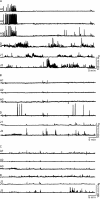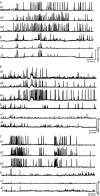Involvement of two different pathways in the motor effects of erythromycin on the gastric antrum in humans
- PMID: 9863486
- PMCID: PMC1727256
- DOI: 10.1136/gut.43.3.395
Involvement of two different pathways in the motor effects of erythromycin on the gastric antrum in humans
Abstract
Background: During the interdigestive state in humans, erythromycin 40 mg induces a premature activity front that starts in the stomach, while erythromycin 200 mg induces a prolonged period of enhanced antral contractile activity.
Aims: To study the involvement of a cholinergic pathway in the motor effects of erythromycin using the muscarinic antagonist atropine and the neural 5-HT1 receptor agonist sumatriptan.
Methods: In 30 healthy volunteers, fasted antroduodenojejunal motor activity was studied by stationary manometry. Placebo (n = 10), atropine (15 micrograms/kg intravenous bolus plus 15 micrograms/kg/h over 30 minutes; n = 10), or sumatriptan (6 mg subcutaneously; n = 10) was administered, followed by infusion of erythromycin 40 mg or 200 mg.
Results: After placebo, erythromycin 40 mg induced a premature activity front with gastric onset after 19.1 (1.7) minutes in all volunteers. After atropine, erythromycin 40 mg failed to induce a premature activity front during a 60 minute period in all volunteers (p < 0.001), while sumatriptan prevented the induction of a premature activity front during a 60 minute period in all but one volunteer (p < 0.005). The number of antral contractions and their mean amplitude in the 60 minutes after erythromycin 200 mg did not differ significantly after atropine or sumatriptan versus placebo.
Conclusions: The antral motor effects of erythromycin in humans are mediated via different pathways. The induction of a premature activity front is mediated through activation of an intrinsic cholinergic pathway, while the induction of enhanced antral contractile activity may be mediated via a pathway potentially involving activation of a muscular receptor.
Figures


References
Publication types
MeSH terms
Substances
LinkOut - more resources
Full Text Sources
Medical
